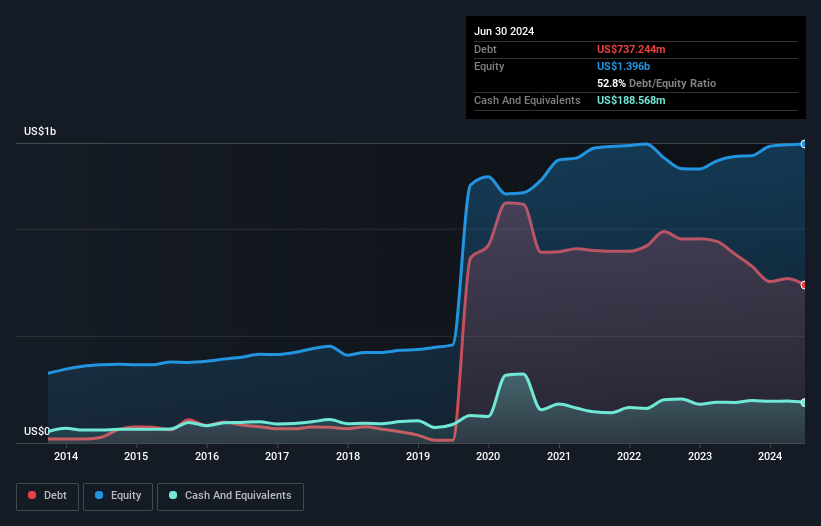
Legendary fund manager Li Lu (who Charlie Munger backed) once said, 'The biggest investment risk is not the volatility of prices, but whether you will suffer a permanent loss of capital.' So it might be obvious that you need to consider debt, when you think about how risky any given stock is, because too much debt can sink a company. As with many other companies Quaker Chemical Corporation (NYSE:KWR) makes use of debt. But is this debt a concern to shareholders?
When Is Debt Dangerous?
Debt assists a business until the business has trouble paying it off, either with new capital or with free cash flow. In the worst case scenario, a company can go bankrupt if it cannot pay its creditors. However, a more usual (but still expensive) situation is where a company must dilute shareholders at a cheap share price simply to get debt under control. Of course, debt can be an important tool in businesses, particularly capital heavy businesses. The first thing to do when considering how much debt a business uses is to look at its cash and debt together.
See our latest analysis for Quaker Chemical
How Much Debt Does Quaker Chemical Carry?
The image below, which you can click on for greater detail, shows that Quaker Chemical had debt of US$737.2m at the end of June 2024, a reduction from US$883.3m over a year. However, it does have US$188.6m in cash offsetting this, leading to net debt of about US$548.7m.

How Strong Is Quaker Chemical's Balance Sheet?
According to the last reported balance sheet, Quaker Chemical had liabilities of US$350.1m due within 12 months, and liabilities of US$926.5m due beyond 12 months. On the other hand, it had cash of US$188.6m and US$423.9m worth of receivables due within a year. So its liabilities outweigh the sum of its cash and (near-term) receivables by US$664.1m.
While this might seem like a lot, it is not so bad since Quaker Chemical has a market capitalization of US$3.03b, and so it could probably strengthen its balance sheet by raising capital if it needed to. But we definitely want to keep our eyes open to indications that its debt is bringing too much risk.
We use two main ratios to inform us about debt levels relative to earnings. The first is net debt divided by earnings before interest, tax, depreciation, and amortization (EBITDA), while the second is how many times its earnings before interest and tax (EBIT) covers its interest expense (or its interest cover, for short). The advantage of this approach is that we take into account both the absolute quantum of debt (with net debt to EBITDA) and the actual interest expenses associated with that debt (with its interest cover ratio).
Quaker Chemical has net debt worth 1.8 times EBITDA, which isn't too much, but its interest cover looks a bit on the low side, with EBIT at only 4.8 times the interest expense. While that doesn't worry us too much, it does suggest the interest payments are somewhat of a burden. We saw Quaker Chemical grow its EBIT by 9.2% in the last twelve months. That's far from incredible but it is a good thing, when it comes to paying off debt. The balance sheet is clearly the area to focus on when you are analysing debt. But ultimately the future profitability of the business will decide if Quaker Chemical can strengthen its balance sheet over time. So if you're focused on the future you can check out this free report showing analyst profit forecasts.
Finally, while the tax-man may adore accounting profits, lenders only accept cold hard cash. So it's worth checking how much of that EBIT is backed by free cash flow. During the last three years, Quaker Chemical produced sturdy free cash flow equating to 63% of its EBIT, about what we'd expect. This cold hard cash means it can reduce its debt when it wants to.
Our View
Happily, Quaker Chemical's impressive conversion of EBIT to free cash flow implies it has the upper hand on its debt. And its EBIT growth rate is good too. Looking at all the aforementioned factors together, it strikes us that Quaker Chemical can handle its debt fairly comfortably. On the plus side, this leverage can boost shareholder returns, but the potential downside is more risk of loss, so it's worth monitoring the balance sheet. Over time, share prices tend to follow earnings per share, so if you're interested in Quaker Chemical, you may well want to click here to check an interactive graph of its earnings per share history.
If you're interested in investing in businesses that can grow profits without the burden of debt, then check out this free list of growing businesses that have net cash on the balance sheet.
Valuation is complex, but we're here to simplify it.
Discover if Quaker Chemical might be undervalued or overvalued with our detailed analysis, featuring fair value estimates, potential risks, dividends, insider trades, and its financial condition.
Access Free AnalysisHave feedback on this article? Concerned about the content? Get in touch with us directly. Alternatively, email editorial-team (at) simplywallst.com.
This article by Simply Wall St is general in nature. We provide commentary based on historical data and analyst forecasts only using an unbiased methodology and our articles are not intended to be financial advice. It does not constitute a recommendation to buy or sell any stock, and does not take account of your objectives, or your financial situation. We aim to bring you long-term focused analysis driven by fundamental data. Note that our analysis may not factor in the latest price-sensitive company announcements or qualitative material. Simply Wall St has no position in any stocks mentioned.
About NYSE:KWR
Quaker Chemical
Quaker Chemical Corporation, doing business as Quaker Houghton, provides industrial process fluids for steel, aluminum, automotive, aerospace, offshore, can, mining, and metalworking companies worldwide.
Flawless balance sheet, undervalued and pays a dividend.


